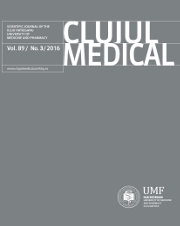The contribution of computerized axiography to the functional evaluation of the temporomandibular joint: a case report
DOI:
https://doi.org/10.15386/cjmed-618Keywords:
computerized axiography, temporomandibular jointAbstract
The aim of this case report is to give comprehensive information on the clinical use of computerized axiography (CA) in the evaluation of temporomandibular joint (TMJ) mobility in a patient who undergoes orthognatic surgery. A 20-year-old female patient with class III skeletal anomaly and who underwent orthognatic surgery is presented. Pre- and postsurgical CA recordings for the patient are compared in order to evaluate the functional modifications that appear. The CA is a functional investigation of the TMJ and records the border movements of the mandible: protrusion, lateral movements and open/close. The starting point for every movement is the centric relation position. This allows for very high reproducibility of the CA and the data can later become available for comparison of examinations performed at different times. The CA can offer data to programme an articulator or to evaluate the functional evolution of the TMJs after various occlusal interventions (prosthodontic, orthodontic or orthognatic). After comparing the pre- and postsurgical CA recordings, a significant improvement of the TMJ function after the repositioning of the maxilla and mandible through orthognatic surgery was confirmed. In conclusion, our case confirms the results in literature that CA is a reproducible and reliable investigation method in the evaluation of TMJ function in orthognatic surgery patients, that it facilitates the monitoring of the evolution of the functionality of the TMJ ever time and that it allows for comparative evaluation of the two TMJs.
Downloads
Published
How to Cite
Issue
Section
License
The authors are required to transfer the copyright of the published paper to the journal. This is done by agreeing to sign the Copyright Assignment Form. Whenever the case, authors are also required to send permissions to reproduce material (such as illustrations) from the copyright holder.

The papers published in the journal are licensed under a Creative Commons Attribution-NonCommercial-NoDerivatives 4.0 International License.

